|
rf9553a.exe Model 53 Reference Disk v1.10 (zipped image)
rd9553a.exe Model 53 Diagnostic Disk v1.00 (zipped image)
rf5055pu.exe PS/2 8550/50Z/55 Planar Upgrade refdisk v1.01
193-350 53 486SLC2 (-0B7 / 0BB) 53LS 486SLC2 (-1BX / 2BX)
193-313 IBM Planar Upgrades For PS/2 Models 50, 50Z, 55 SX And LS (summary only)
9553 Planar
System Firmware
ROM Images
Specifications
9553 Origins
Remove Password
Serial and Parallel Ports
IDE Controller Trivia
Floppy Cable Hack
Windows 95 drivers
Graphic Modes Supported
Power Manageable Display
9553 Riser
Power Supply
Open the Case
9553 Planar / Reply TurboProcessor 55 P/N 71G5951
![Top [P]](/other/img/photo.gif) | |
![Top (alt) [P]](/other/img/photo.gif)
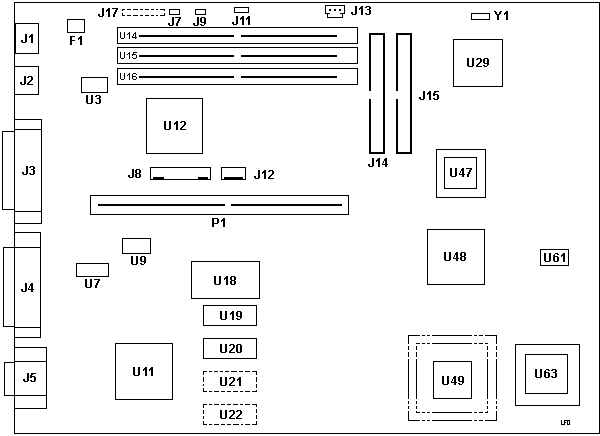
F1 PTC for KB/mouse
J1 Keyboard port
J2 Mouse port
J3 Parallel port
J4 DB25 serial port
J5 HDD15 video connector
J7 HD LED
J8 12-pin PSU connector #1
J9 Privilege access password
J11 Password-override connector
J12 4-pin PSU connector #2
J13 3-pin HD power connector
J14 40-pin IDE header
J15 40-pin Floppy header
J17 Solder pads
U3 22.1184 MHz osc (UART)
|
U7 LT1141CS
U9 14.31818 MHz osc
U11 CL-GD5426-80QC-A SVGA
U12 10G4672 I/O controller
U14-16 72-pin SIMM socket
U18 Dallas DS1387 RTC/CMOS
U19,20 KM416C256AJ-6 or compatible
U21,22 Pads for video RAM
U29 82077SL Floppy controller
U35 CSI CAT28F010N-15 flash BIOS?
U47 PLCC-44 ROM BIOS?
U48 96F7690 System controller?
U49 50G6950 IBM 486SLC2 CPU
U61 50.0000 MHz osc (CPU)
U63 PLCC Socket for 387SX
Y1 R24CA33 xtal
|
U47 BIOS - MX 82G1767 or 02N3251 G1.04
System Firmware (POST & BIOS)
Firmware stored in EPROM (U47) and Flash (U35)?
ROM Images
Not available yet.
Specifications
Supports only 2, 4, and 8 MB / 70 ns SIMMs (3 slots)
The Enhanced 2.88MB diskette drives (#1272, 6451272) electronic diskette
eject button feature is supported. The software-controlled diskette eject
feature and the ability to lock a diskette into or out of the drive are not
supported.
Video Controller CL-GD5426-80QC
Video Memory- 1MB DRAM (2 SOJ)
640x480, 16M: 24 bits/pixel
800x600, 64K: 16 bits/pixel
1,024x768, 256: 8 bits/pixel
Parallel: One enhanced, bi-di with DMA support
Serial - one enhanced with DMA support
HD Support AT/IDE and existing drive
Floppy controller supports 1.44 and 2.88MB floppies
Clock/calendar integrated CMOS battery
9553 Origins
They're souped-up 8555SX with the Reply Corp. planar. IBM made them
originally as "special bid" units for certain customers that needed a machine
with small footprint and better performance than the odd 386SX-16. It turned
out to be so good that IBM officially made it Mod. 53. The leading 95- is a
result of the onboard Cirrus Logic SVGA - making the units "PS/2 Premium Line"
machines. The 9553 uses a SurePath BIOS.
Remove Password (from Bob Eager)
Look for jumper J11, on the right hand side of the system board (looking
from the front); about halfway along the edge of the memory connectors, between
them and the edge of the board.
This is a 3 pin arrangement with the jumper bridging the middle pin and one
other. Move it so that it bridges the middle and the other pin.
Power the machine up. No need to put the jumper back; it's the CHANGE that
is detected.
Serial and Parallel Ports
Serial ports use IRQ 3 and 4 with MANY IO choices
Parallel port is DMA arbitrated and uses IBM IO and IRQ7 only.
IDE Controller Trivia
(from the planar ADF PE3FE.ADF on the refdisk)
Scroll down to the last section in the Planar ADF and you will see:
NamedItem Prompt "ATA Fixed Disk"
choice "Enabled"
pos[20]=XXXXXX11b io 1f0h-1f8h int 0eh
; choice "Alternate"
; pos[20]=XXXXXX01b io 170h-178h int 0eh
choice "Disabled"
pos[20]=XXXXXXX0b
If you want to use the alternate IRQ14/IO170h-178h, remove both of the ";"
from this section. Save the file and reboot with the refdisk.
ATA Fixed Disk
<"Enabled" (1f0h-1f8h int
14)>, Disabled
These options are commented out: Alternate (170h-178h int 14)
Floppy Cable Hack (71G6009)
These little dapper devils are relatively simple. Parts: 40-pin IDC, Clone
floppy cable.
The cable goes straight from the 40 pin header out to the first floppy
connector, then it twists pins 10-16 around, then continues with pins 17-34.
Optional: Take needlenose pliers, pull the
insulation displacing points on the 40-pin header at 3, 6, 35, 36, 37, and 39.
Leave 38 and 40 at the end.


Now measure out 9". You should have about 2" past the 40 pin header.
Now bring out 3 and 6, cut the rest of the conductors flush at the 40 pin. Now
bring them around the back, over 38 and 40 and exit the connector towards
the 34 pin header. Crimp. A little ticklish getting 3 and 6 onto the slots of
38 and 40, but it's sooo much neater.
Windows 95 drivers
The "Cirrus Logic" driver included in the Windows 95 distribution
disk(s) should support most implementations of the CL-GD542X chips, but
only if it has a video BIOS version of 1.30 or newer.
Check this with MSD, IDCHIP.EXE, or a similar utility.
If you have a BIOS that is to old you must get a update from the video
board manufacturer to use Win95 with your board.
Graphic Modes Supported
| Graphics Modes |
Colors/Palette |
Device Drivers Support |
Monitor Support
Vertical Freq. [Hz] |
| DOS |
Win |
OS/2 |
| 640 x 480 |
16/256K |
Y(i) |
Y |
Y |
60, 72 |
| 640 x 480 |
256/256K |
Y |
Y |
Y(a) |
60, 72 |
| 640 x 480 |
32K |
- |
- |
- |
60, 72 |
| 640 x 480 |
64K |
- |
Y |
- |
60, 72 |
| 640 x 480 |
16M |
- |
Y |
- |
60 |
| 800 x 600 |
16/256K |
Y |
Y |
Y(b) |
56, 60, 72 |
| 800 x 600 |
256/256K |
Y |
Y |
Y(a) |
56, 60, 72 |
| 800 x 600 |
32K |
- |
- |
- |
56 |
| 800 x 600 |
64K |
- |
Y |
- |
56, 60 |
| 1024 x 768 |
16/256K |
Y |
Y |
Y(b) |
60, 70, 72, 87(c) |
| 1024 x 768 |
256/256K |
Y |
Y |
Y(i,a) |
60, 70, 72, 87(c) |
Note (i) ISO certified with specific fonts, typeface, and monitors.
Note (a) Not supported by OS/2 1.3.x or 2.0 w/o Service Pack.
Note (b) Not supported by OS/2 2.0 with Service Pack or 2.1
Note (c) Interlaced
The system maintains compatibility with CGA, EGA, and VGA modes.
Power Manageable Display
If you have attached to this system a power manageable display that conforms
to the\VESA Display Power Management Signaling (DPMS) interface, like IBM 952n
or 632n Color Monitors, then using the DPMS enabled BIOS utility package will
save you power. The power savings is accomplished by instructing your display
to go into various power saving states after a period of user inactivity has
been detected. DPMS will put your power manageable display into one of three
different states:
- Standby: Minimum power savings but immediate return to ON.
- Suspend: Medium power savings but medium return to ON.
- Off: Maximum power savings but noticeable delay in return to ON.
The timeout defaults may be changed from 1 to 99 minutes.
After December 1993, the DOS and Windows* DPMS utility package may be
obtained from:
IBM PC Company BBS - (919) 517-0001
OS/2 BBS accessed via ADVANTIS
CompuServe Information Service
(time machine required)
9553 Riser FRU P/N 27F4666
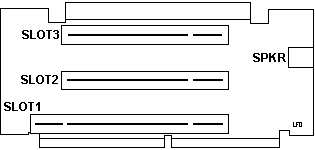
William Walsh says:
The 72-pin edgecard is for a DBA ESDI hard disk. It's supposedly
disabled in the BIOS on the IBM Model 53.
Riser bracket is 27F4599
Power Supply
90-watt worldwide, manual switch, power supply with cooling fan, average of
1.6 amps per slot.
Open the Case
Use a standard screwdriver to free up the two captive screws on the lower
front sides. Slide the top back about 1/2 inch, lift it straight up.
Install Cover
First, look at the lower rear of the cover. Notice the bottom edge has about
a 3/4 inch angle where it does not reach the end. Hold the cover so the back
edge is over the rear side of the case. Lower it down until it rests on the
case rails, then pull forward.
Note: The front bezel snaps onto the case frame.
When you open the case, you will have a wide "U" shaped cover in your hand, the
front bezel stays put!
Remove Front Bezel (photos and additional info from David Beem)
Remove the cover. Look to the outer side of the speaker/card guide assembly.
See the two white latches? Press them outwards and pop that end off. Now look
at the other side by the power switch. See the wide latch? Press it inwards and
pop the front bezel off.
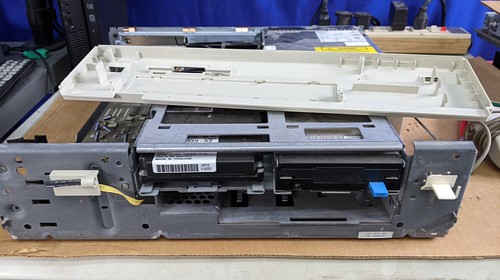
There are quick-release latches because the outer bezel is one piece, with
the diskette drive in the opposite upper bay from the other PS/2 models having
that case style. Only the bottom bay has a removable bezel.
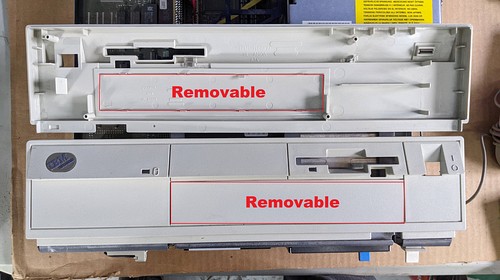
The lower bay has the dual 5-1/4" and 3-1/2" sled slots like the Model 70
drive platform.
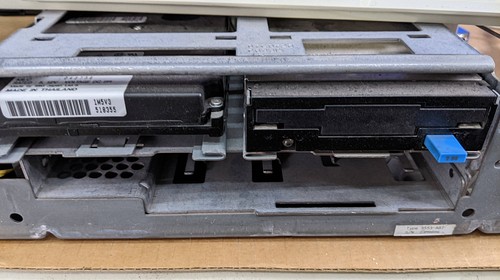
It's unclear why does the bottom bay extend beyond the usual 5-1/4" bay
width.
|